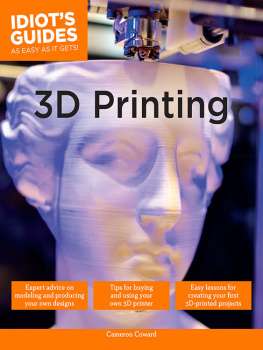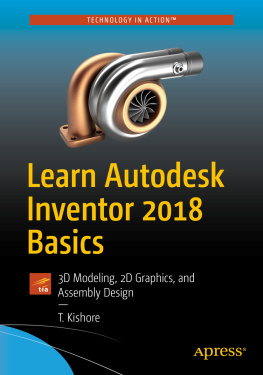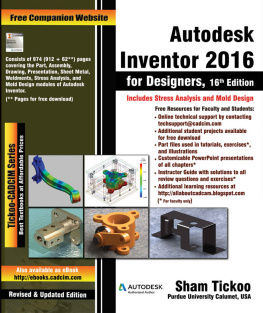Contents in Detail
A BEGINNERS GUIDE TO 3D MODELING
A Guide to Autodesk Fusion 360
by Cameron Coward
San Francisco
A BEGINNERS GUIDE TO 3D MODELING. Copyright 2019 by Cameron Coward.
All rights reserved. No part of this work may be reproduced or transmitted in any form or by any means, electronic or mechanical, including photocopying, recording, or by any information storage or retrieval system, without the prior written permission of the copyright owner and the publisher.
ISBN-10: 1-59327-926-4
ISBN-13: 978-1-59327-926-4
Publisher: William Pollock
Production Editor: Janelle Ludowise
Cover Illustration: Limehouse Design
Interior Design: Octopod Studios
Developmental Editors: Frances Saux and Zach Lebowski
Technical Reviewer: Aron Rubin
Copyeditors: Barton D. Reed and Paula L. Fleming
Compositor: Maureen Forys, Happenstance Type-O-Rama
Proofreader: James Fraleigh
The following images are reproduced with permission: ).
For information on distribution, translations, or bulk sales, please contact No Starch Press, Inc. directly:
No Starch Press, Inc.
245 8th Street, San Francisco, CA 94103
phone: 1.415.863.9900;
www.nostarch.com
Library of Congress Cataloging-in-Publication Data
Names: Coward, Cameron, author.
Title: A beginner's guide to 3D modeling : a guide to Autodesk Fusion 360 /
Cameron Coward.
Other titles: Beginner's guide to three dimensional modeling
Description: First edition. | San Francisco : No Starch Press, Inc., [2019]
Identifiers: LCCN 2019003389 (print) | LCCN 2019009343 (ebook) | ISBN
9781593279271 (epub) | ISBN 1593279272 (epub) | ISBN 9781593279264 (print) |
ISBN 1593279264 (print)
Subjects: LCSH: Fusion 360--Popular works. | Three-dimensional
modeling--Popular works. | Computer-aided design--Popular works.
Classification: LCC T386.F87 (ebook) | LCC T386.F87 C69 2019 (print) | DDC
620/.0042028553--dc23
LC record available at https://lccn.loc.gov/2019003389
No Starch Press and the No Starch Press logo are registered trademarks of No Starch Press, Inc. Other product and company names mentioned herein may be the trademarks of their respective owners. Rather than use a trademark symbol with every occurrence of a trademarked name, we are using the names only in an editorial fashion and to the benefit of the trademark owner, with no intention of infringement of the trademark.
The information in this book is distributed on an As Is basis, without warranty. While every precaution has been taken in the preparation of this work, neither the author nor No Starch Press, Inc. shall have any liability to any person or entity with respect to any loss or damage caused or alleged to be caused directly or indirectly by the information contained in it.
This book is dedicated to my mother.
I know she would have been proud.
About the Author
Cameron Coward is an author, maker, and former mechanical designer/drafter. He got his start in CAD while working on a degree in drafting, and spent several years modeling parts and assemblies in the medical, automotive, and furniture industries. These days, he focuses on CAD modeling for 3D printing and other hobby projects. He is a regular contributing author for Hackster.io and Hackaday.com, and is the author of Idiots Guides: 3D Printing.
About the Technical Reviewer
Aron Rubin is currently Chief Scientist at Dynamic Imaging Systems Inc., where he is developing new products for law enforcement. Prior to that, Aron served as a Senior Software Engineer in Lockheed Martins Advanced Technology Laboratories, where he helped develop breakthrough solutions in the fields of robotics, machine autonomy, machine vision, and more. Arons love of CAD started in childhood, when he became fascinated with 3D rendering. He has since applied CAD and CAM to hundreds of projects fabricated through machining, 3D printing, molding, woodworking, circuit printing, and screen rendering.
BRIEF CONTENTS
ACKNOWLEDGMENTS
Writing a book, even on a subject you love, is a long and laborious task that cant be done without a great team of people helping you along the way. I found that team at No Starch Press, and would like to thank everyone there who was instrumental in bringing this book to you. Specifically, I want to thank Bill Pollock, Janelle Ludowise, Annie Choi, Zach Lebowski, Frances Saux, Meg Sneeringer, Liz Chadwick, Rhiannon Elliot, Amanda Hariri, Aron Rubin, and everyone else who was working behind the scenes.
An endeavor like this also requires a lot of support from friends, family, and loved ones. Id like to acknowledge the people who helped me get through the writing process with motivation and support, including Stephanie, Daniel, Sean, Samantha, Dad, Danielle, and Shelby. Thank you all for being there for me!
Finally, I want to thank you, the maker community, and everyone at Hackster.io and Hackaday.com. Without such a fantastic group of enthusiastic people, there never would have been a market for my writing or this book. The maker community has provided both a resource for me to learn, and an audience for my writing about what Ive learned. Most importantly, I have found a community where I feel like I belong.
INTRODUCTION
3D printing technologies have revolutionized the engineering world. Just a decade or two ago, designers used to spend weeks constructing prototypes that now take only a few hours to complete. Similarly, a company might have easily poured thousands of dollars into a single prototype part, only to find that it didnt work properly.
Today, engineering teams produce and test parts at a trivial cost. You likely purchased a 3D printer for these reasons. Whether youre a maker, a hacker, an artist, or simply a tinkerer, you wanted the freedom to create your own physical objects.
But while operating a 3D printer is easy, the process of actually designing your models has a significantly steeper learning curve. If youre like most people, youve probably downloaded and printed models you found online. That may be entertaining for a time, but you bought a 3D printer, or gained access to one through your school or makerspace, in order to bring your ideas to life, not just to replicate the designs created by others.
In this book, youll learn everything you need to know to design your very own 3D models with Autodesk Fusion 360, a parametric modeling software thats free for noncommercial use. (If youd like to take advantage of these skills at work, you can also get a commercial license.) Ill walk you through the fundamentals of the modeling process and then introduce you to advanced tools, drafting, and rendering.
To get started, lets discuss some basic concepts to help you determine whether Autodesk Fusion 360 is the right software to create the models you want.
Who This Book Is For
This book is for anyone who wants to learn how to operate Autodesk Fusion 360, which is parametric computer-aided design (CAD) software you can use to create models for 3D printing or manufacturing. Fusion 360 is easily the most advanced CAD software thats free for hobbyists to use. That said, you wont need any previous experience with CAD or 3D modeling softwareor even with 3D printing, if you plan to have your models printed professionallyto work through this book.
















